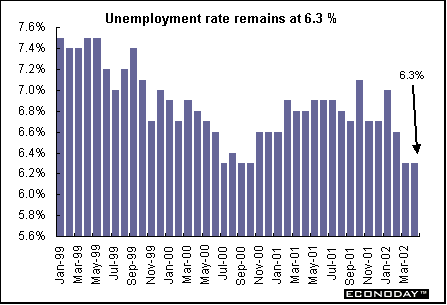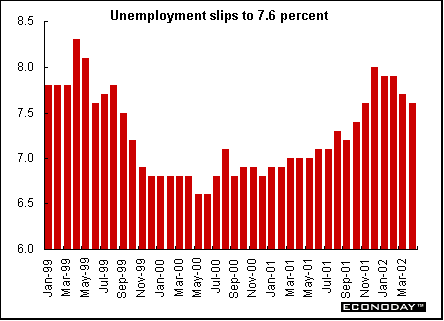
Indicator scoreboard
EMU - April Reuters PMI services activity index rose to 53.3 from 53.1 in the prior month. This was the fourth month that the index rose. The index rose at a slower pace than in recent months, as more rapid growth in France and Spain was largely offset by modest slowdowns in Italy and Germany. When the index is above 50 the activity is expanding, and when the index is below 50, it is contracting. Reuters' composite index, which combines service and industrial sector PMIs, posted its third month of expansion, rising to 53.2 from 51.3.
Revised fourth-quarter 2001 real gross domestic product declined 0.2 percent but rose 0.6 percent on the year. An upward revision in capital investment and government spending was offset by larger-than-initially reported declines in inventories and net exports.

Germany - April seasonally adjusted unemployment rate was unchanged at 9.6 percent, according to the Bundesbank. East German unemployment rate rose to 17.7 while in the west, it remained at 7.7 percent. The number of unemployed rose by 6,000 with east Germany accounting for 5,000 of the increase and west Germany 1,000.

March manufacturing orders slipped 0.1 percent and dropped 3.5 percent when compared with last year. West German orders fell 0.9 percent while east German orders rose 11.9 percent. Domestic orders sank 2.6 percent while foreign orders rose 3.1 percent. The data underline that what strength there is in German industry is coming from abroad. In March, domestic demand declined and foreign demand rose in all subcategories.

March seasonally adjusted industrial production fell 0.8 percent and 3.8 percent when compared with last year. All major industrial production categories declined in March, led by a sharp 5.8 percent drop in the construction sector. Excluding construction, March industrial production fell 0.3 percent. Manufacturing output fell 0.3 percent. In west Germany, industrial output fell a seasonally adjusted 0.7 percent while in the east production fell 1.5 percent.

March seasonally adjusted merchandise trade surplus stood at E11.9 billion, up from an E9.5 billion surplus in February. Exports rose 2.1 percent and 3.2 percent when compared with last year. Imports were down 2.8 percent and 4.3 percent on the year.
Britain - March industrial output fell 0.4 percent and was down 5.9 percent when compared with last year. Manufacturing output was down 0.8 percent on the month and 6.8 percent on the year. The monthly decline in manufacturing output was largely due to declines in the production of chemicals and man-made fibers and transport equipment. Chemical sector output fell 2.9 percent and transport equipment fell 1.9 percent, accounting for 70 percent of the monthly decline in manufacturing output.

March global merchandise trade deficit widened to Stg3.004 billion from Stg2.592 billion deficit in February. Exports fell 1.3 percent while imports rose 1.2 percent. The volume of exports dropped 3.3 percent and imports rose 0.8 percent. The widening in the trade gap was mainly due to deterioration in the deficit with EU countries. The value of exports to EU countries fell by 3.4 percent and the value of imports rose 0.9 percent. When oil and erratic items are excluded, the underlying whole world goods deficit widened to Stg3.317 billion from Stg3.032 billion in February.
Asia
Japan - Seasonally adjusted spending by households of two or more people rose 0.2 percent in the three months ended March 31 from the previous quarter. March spending increased 1.1 percent but was down 1.0 percent on the year. The month-to-month increase suggests consumer spending, which accounts for 55 percent of gross domestic product, may help Japan's economy return to growth after shrinking for three straight quarters.
Australia - April seasonally adjusted unemployment rate remained at 6.3 percent. However, the number of employed fell by 43,000. The decline came at the expense of full time jobs as fewer people looked for work, more than offsetting the creation of 21,200 jobs in March. The seasonally adjusted workforce participation rate, or the proportion of working-age persons at work or actively seeking work, fell to 63.4 percent from 63.8 percent in March.

Americas
Canada - April unemployment rate fell to 7.6 percent from 7.7 percent in the previous month. Employment rose by 36,000 and has risen by 1.4 percent over the first four months of 2002. The April increase was concentrated in full time employment while part time employment fell by 4,800. Self employment rose by 30,000 for its first increase in two years. The goods producing sector lost 19,200 jobs with 18,700 of that in manufacturing.



Last Week's Highlights • Global
Stock Market Indexes • Recap of Global Markets
• Currencies • Indicator
Scoreboard

The Bottom Line •
Looking Ahead
|